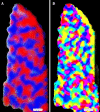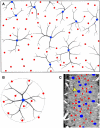Recent Advances in High-Resolution MR Application and Its Implications for Neurovascular Coupling Research
- PMID: 21048903
- PMCID: PMC2967427
- DOI: 10.3389/fnene.2010.00130
Recent Advances in High-Resolution MR Application and Its Implications for Neurovascular Coupling Research
Abstract
The current understanding of fMRI, regarding its vascular origins, is based on numerous assumptions and theoretical modeling, but little experimental validation exists to support or challenge these models. The known functional properties of cerebral vasculature are limited mainly to the large pial surface and the small capillary level vessels. However, a significant lack of knowledge exists regarding the cluster of intermediate-sized vessels, mainly the intracortical, connecting these two groups of vessels and where, arguably, key blood flow regulation takes place. In recent years, advances in MR technology and methodology have enabled the probing of the brain, both structurally and functionally, at resolutions and coverage not previously attainable. Functional MRI has been utilized to map functional units down to the levels of cortical columns and lamina. These capabilities open new possibilities for investigating neurovascular coupling and testing hypotheses regarding fundamental cerebral organization. Here, we summarize recent cutting-edge MR applications for studying neurovascular and functional imaging, both in humans as well as in animal models. In light of the described imaging capabilities, we put forward a theory in which a cortical column, an ensemble of neurons involved in a particular neuronal computation is spatially correlated with a specific vascular unit, i.e., a cluster of an emerging principle vein surrounded by a set of diving arteries. If indeed such a correlation between functional (neuronal) and structural (vascular) units exist as a fundamental intrinsic cortical feature, one could conceivably delineate functional domains in cortical areas that are not known or have not been identified.
Keywords: columns; cortical vessels; fMRI; high-resolution; vascular-unit.
Figures






Similar articles
-
Quantitative In Vivo Imaging of Tissue Absorption, Scattering, and Hemoglobin Concentration in Rat Cortex Using Spatially Modulated Structured Light.In: Frostig RD, editor. In Vivo Optical Imaging of Brain Function. 2nd edition. Boca Raton (FL): CRC Press/Taylor & Francis; 2009. Chapter 12. In: Frostig RD, editor. In Vivo Optical Imaging of Brain Function. 2nd edition. Boca Raton (FL): CRC Press/Taylor & Francis; 2009. Chapter 12. PMID: 26844326 Free Books & Documents. Review.
-
Dependence of resting-state fMRI fluctuation amplitudes on cerebral cortical orientation relative to the direction of B0 and anatomical axes.Neuroimage. 2019 Aug 1;196:337-350. doi: 10.1016/j.neuroimage.2019.04.036. Epub 2019 Apr 17. Neuroimage. 2019. PMID: 31002965 Free PMC article.
-
fMRI at High Spatial Resolution: Implications for BOLD-Models.Front Comput Neurosci. 2016 Jun 28;10:66. doi: 10.3389/fncom.2016.00066. eCollection 2016. Front Comput Neurosci. 2016. PMID: 27445782 Free PMC article. Review.
-
A critical role for the vascular endothelium in functional neurovascular coupling in the brain.J Am Heart Assoc. 2014 Jun 12;3(3):e000787. doi: 10.1161/JAHA.114.000787. J Am Heart Assoc. 2014. PMID: 24926076 Free PMC article.
-
Macromolecular crowding: chemistry and physics meet biology (Ascona, Switzerland, 10-14 June 2012).Phys Biol. 2013 Aug;10(4):040301. doi: 10.1088/1478-3975/10/4/040301. Epub 2013 Aug 2. Phys Biol. 2013. PMID: 23912807
Cited by
-
Vascular Supply of the Cerebral Cortex is Specialized for Cell Layers but Not Columns.Cereb Cortex. 2015 Oct;25(10):3673-81. doi: 10.1093/cercor/bhu221. Epub 2014 Sep 21. Cereb Cortex. 2015. PMID: 25246513 Free PMC article.
-
Using a novel source-localized phase regressor technique for evaluation of the vascular contribution to semantic category area localization in BOLD fMRI.Front Neurosci. 2015 Nov 3;9:411. doi: 10.3389/fnins.2015.00411. eCollection 2015. Front Neurosci. 2015. PMID: 26578868 Free PMC article.
-
Mapping vascular network architecture in primate brain using ferumoxytol-weighted laminar MRI.Elife. 2025 Jun 11;13:RP99940. doi: 10.7554/eLife.99940. Elife. 2025. PMID: 40497449 Free PMC article.
-
Modern Brain Mapping - What Do We Map Nowadays?Front Psychiatry. 2015 Jun 16;6:89. doi: 10.3389/fpsyt.2015.00089. eCollection 2015. Front Psychiatry. 2015. PMID: 26136692 Free PMC article. Review. No abstract available.
-
Ultra high-resolution fMRI and electrophysiology of the rat primary somatosensory cortex.Neuroimage. 2013 Jun;73:113-20. doi: 10.1016/j.neuroimage.2013.01.062. Epub 2013 Feb 4. Neuroimage. 2013. PMID: 23384528 Free PMC article.
References
Grants and funding
LinkOut - more resources
Full Text Sources

